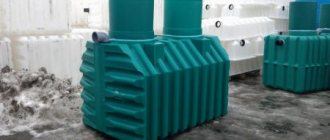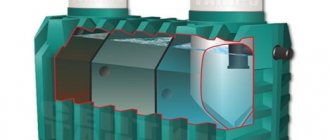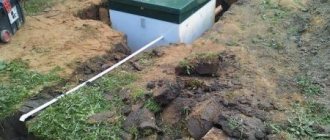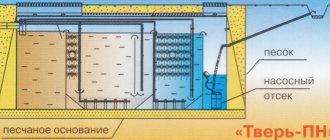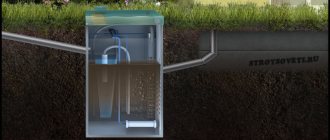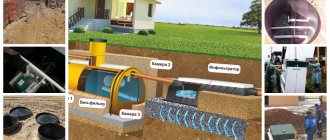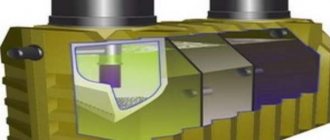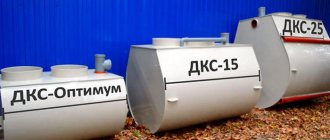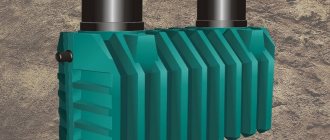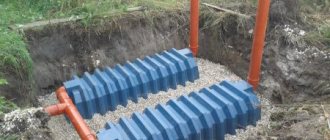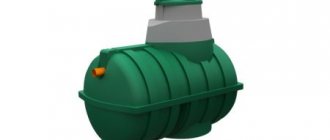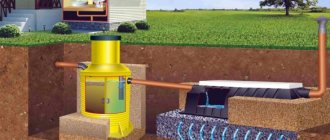A modern country house is as comfortable as a city apartment. It is equipped with a toilet, shower, washing machine and dishwasher. At the same time, centralized sewerage is most often absent. Its functions can be performed by a septic tank for a summer residence Tank, in which wastewater is accumulated and partially processed.
The treatment plant has gained popularity due to its simplicity of design, reliability and affordable cost. Are you unsure about your purchase? We invite you to familiarize yourself with the structure and operating principle of a septic tank, its pros and cons, as well as the rules for installation and maintenance.
The information presented will help you decide on the choice of modification of the Tank purifier and understand the feasibility of its installation. The material will also be useful to those who already use a storage septic tank at their dacha.
Construction of a septic tank “Tank”
A septic tank is a treatment facility in which accumulation, sedimentation and partial biological purification of wastewater occurs. It consists of one to three sections connected in series, the last of which is divided into two chambers.
The second chamber contains a biofilter designed for anaerobic processing of wastewater, and a floating load that performs filtration at the outlet of the tank.
Image gallery
Photo from
Cast structures for autonomous sewage systems
Model range of septic tanks for arranging a summer house
A set of devices for sewerage construction
Advantages of a ribbed plastic case
As a result of multi-stage purification in the process of overflow, treatment with bacteria and filtration, the purification degree reaches 78-80%. After leaving the treatment plant, the wastewater enters an infiltrator installed on the ground. Here, additional purification takes place up to 95 - 100% and the purified mass is discharged into the underlying layers of soil, filtration fields or sewers.
The installation of septic tank sections, the laying of inlet and outlet communications should be carried out in strict accordance with the manufacturer’s recommendations and in relation to the specific geological and hydrogeological situation on the site (+)
At dachas, devices presented in one housing are most often used.
The structure consists of the following elements:
- Housing , the volume of which is divided into two or three sections by partitions with overflows.
- Biofilter with polymer floating loading.
- Branch pipes - inlet and outlet.
- One or two necks with tight-fitting lids.
The number of sections in a septic tank depends on its total volume. Two chambers have small-volume septic tanks capable of processing up to 600 liters of wastewater per day ( Tank-1 ). The rest are divided into three parts.
The sewer treatment system with the Tank logo can include one or more sections depending on the processing needs
The productivity (daily volume of water disposal) of single-body septic tanks, depending on the modification, is enough to serve from one to six residents, which corresponds to water disposal within 1200 l/day.
If it is necessary to process a larger amount of wastewater, then separate modules serve as working chambers, each of which in this case performs its own function. This is how the Tank-4 - it consists of three tanks connected by overflows.
In addition, by successively adding additional containers, you can increase the performance of the cleaning system with any version of the Tank septic tank to the required level.
All components are made of polymer materials and are not subject to corrosion, water erosion or soil erosion (+)
Features of the housing design
The body of the device is a monolithic cast container made of ribbed polyethylene, without any seams or joints. Thanks to its rectangular shape, the septic tank is compact and stable, so it is quite easy to install even for a non-professional.
In the upper part of the hull there are one (Tank-1) or two service hatches. The necks are attached to the sealant according to the male-female principle.
Ribbed walls, remaining elastic and resilient at any temperature, increase the rigidity and strength of the structure. If installed correctly, they can withstand soil pressure even during frost heaving.
The ribbed surface increases the adhesion of the tank to the surrounding dense sand-cement cushion, due to which it is firmly held in the ground and does not float up during spring floods. Therefore, the septic tank Tank does not require additional anchoring during installation.
Monolithic cast polypropylene body, reinforced with stiffening ribs, calmly withstands the destructive influences of the environment - uneven soil pressure, periodic washing out with water and temperature changes
The material from which the tank is made is a durable polymer compound. It is completely safe from an environmental point of view, biologically pure material.
It does not decompose under the influence of microorganisms, does not react with chemicals, and is not subject to soil erosion and corrosion. The service life of a polypropylene tank is at least 50 years.
Biofilter design and functions
The biofilter in a septic tank is always installed in the last chamber. It is a container in which optimal conditions are created for the growth and reproduction of bacterial colonies. To ensure the physical possibility of microorganisms settling, the filter is filled with floating bioload.
The main labor force of the biofilter is anaerobic bacteria, colonies of which settle on the walls and bottom of the tanks. Filtration beds are products whose shape allows, with minimal dimensions, to create a large area for mechanical cleaning.
The polymer elements of the floating load are lighter than water, so they float up and are located at the outlet pipe of the section with the biofilter. The manufacturing material is chemically stable and absolutely safe for any aquatic organisms.
Bioload elements have different shapes - they can be simply polymer granules or large chips (crushed pieces). It is important that they create free space capable of “attaching” the maximum amount of contaminants.
The free surface area is the main indicator of the performance of the biological load and determines the capacity of the entire treatment system.
In addition to processing by hydrobionts, centrifugal separation also occurs in the biofilter. The filter container itself is made in a form that allows it to work on the principle of a hydrocyclone.
The inlet holes are located in such a way that water enters at a certain angle (tangentially) and unwinds. Due to vortex microflows, all remaining heavy suspensions are eliminated.
Pros and cons of septic tank Tank
Among the many positive aspects of the Tank septic tank and all its modifications, the following are worth mentioning:
- Affordability (in terms of total costs, the station is even cheaper than its analogue made from concrete rings);
- Energy independence (except for BioTank);
- Possibility of installation on soils of any type and water content;
- Small size and lightweight design, facilitating manual installation;
- High strength plastic housing;
- Extreme ease of operation and maintenance;
- Low probability of clogging of internal chambers;
- Service life up to half a century.
The septic tanks in question can be installed on the site at any time of the year. Problems will arise only with digging frozen ground. You can choose a place for the “Tank” right next to the house at a distance of 2–3 meters from it. It doesn’t matter whether a strip or column foundation is used to build housing, moisture from the sealed housing will not seep into the ground and affect the concrete.
But the infiltrator should be removed from the base of the building, on the contrary, further away. The humidity around it is always high. If you place it next to a residential building, then even precipitation-resistant facade plaster from the walls of the house will sooner or later begin to fall off.
The negative aspects of this septic tank are as follows:
- Large volumes of work when digging a pit for the station and installing an infiltrator;
- The need to organize additional treatment using a filtration field or well.
The effluent in the anaerobic VOC "Tank" is treated only up to 80%. Without the use of an infiltrator, such water cannot be discharged into a reservoir or used for watering beds. In this regard, this septic tank is somewhat inferior to competitors of the same factory design.
Operating principle of the installation
Wastewater treatment in a septic tank Tank occurs only mechanically and biologically, without the use of any chemicals. If the structure includes three sections, then the process is accordingly divided into three stages.
Each stage takes place in its own working area:
- The first section is the reception section. All household waste flows into it through the sewer from the house and settles. Here fermentation and mechanical separation take place - layer-by-layer separation of liquid fractions of different weights. Heavy particles sink to the bottom, light particles (fat, feces, etc.) rise to the surface, and clarified water remains in the middle.
- Second section . Liquid from the middle layer of the primary container enters it through the overflow. Here it continues to ferment under the influence of microorganisms and settle - the movement occurs very slowly, without external disturbances. This promotes the settling of small inclusions that did not have time to precipitate in the previous settling tank.
- The third section is a biofilter. In its lower part, centrifugal separation and purification from residual heavy impurities is carried out. Liquid that is contaminated only of a biological nature approaches the upper part of the filter. When passing through a bioload, where bacterial colonies are concentrated, organic matter is removed.
The solid sediment that has settled to the bottom, formed as a result of filtration, separation and the work of bacteria, must be periodically removed through the hose of the sewer machine.
To prevent the solid components of processed waste that have settled to the bottom from being pressed and compacted, at least once a year it is necessary to pump them out through a hose connected to the vacuum cleaner machine.
Colonies of bacteria that live and multiply in the space of the biological load use organic matter dissolved in water as food. Therefore, recycling occurs naturally. The process produces harmless carbon dioxide, some volatile hydrocarbons and water.
To remove gases, ventilation is installed, which is a mandatory element of the cleaning system. Otherwise, volatile elements released during fermentation and biodegradation will accumulate in the container and be released through the sewer line into the home. An unpleasant odor will fill the building.
Septic tanks Tank are sealed containers in which the biological treatment of wastewater is carried out by anaerobic bacteria, without access to oxygen. These microorganisms are less effective than aerobic microorganisms (used in energy-dependent systems).
Therefore, the degree of purification of water from organic matter when leaving the septic tank reaches 75-80%. Draining such liquid into the ground is prohibited by sanitary standards.
The efficiency of a septic tank depends on the free area of the bioload and the size of the population of microorganisms. The speed of fluid movement in the system also affects the degree of purification - the higher it is, the less pure water comes out of the tank (+)
To further purify wastewater after the Tank septic tank, a ground filtration device must be used. These are structures in which water from a septic tank passes through a layer of crushed stone or gravel. All remaining contaminants settle in the filter mound.
A treatment facility based on a septic tank Tank includes one or more infiltrators that perform post-treatment of wastewater and discharge the treated mass into the ground, filtration fields, and sewers.
Such devices are:
- infiltrators - industrially manufactured tanks without a bottom (resemble an inverted bathtub);
- filtration fields – drainage pipe system;
- filter well - an absorption tank without a bottom with a drainage layer.
The type of structure and installation scheme of the sewer system are selected depending on the type of soil on the site and the groundwater level. It is best to consult a specialist on this issue.
When installed correctly, the septic tank Tank works effectively both in dry weather and during spring floods and heavy rains. It is not afraid of frost heaving and seasonal soil shifts.
The simplest and fastest setup. Suitable for soils characterized by normal water absorption - sandy, gravel, pebble
Expert advice on choosing septic tanks
The choice of a septic tank suitable for a site always remains with its owner; experts advise comparing some parameters of well-known brands of treatment facilities:
- We compare “Unilos” and “Topas”, since they work on almost the same principle. The Unilos septic tank is made of higher quality material, as if it is a continuation of the design solutions of the Topas septic tank. Unilos structures are more suitable for the climatic zones of Russia.
- The “Tank” structure is better in terms of cleaning quality than the “Unilos” and is stronger.
- The Unilos septic tank works better than the Tver structure and requires less maintenance than the Tver one. The remaining parameters are similar.
- When “Topas” and “Tank” are compared, indicators such as the discharge of treated wastewater are taken. At the Tank structure this is done only into the ground, and the Topas septic tank can discharge treated wastewater into a drainage ditch.
Which septic tank to choose is up to the owner of the site, but here we have tried our best to show their advantages and disadvantages.
How to increase system efficiency?
Microorganisms are distributed throughout the entire volume of the septic tank and are concentrated in the bioload. They enter the system along with wastewater, and, if there is a sufficient amount of organic matter, they successfully grow, multiply and eat organic components.
Thanks to bacteria, constant fermentation occurs in the septic tank. Due to this, organic matter, mineral suspensions and fat fractions are separated - the liquid is stratified.
The efficiency of wastewater treatment depends on the size of the microorganism population. The market offers a large selection of ready-made preparations containing colonies of bacteria - bioactivators. A popular drug is “Doctor Robik”.
By periodically adding them to the system, home owners improve the quality of cleaning. This is also an effective prevention against problems that arise when the bacterial population decreases - unpleasant odor, the formation of thick deposits on the walls, hardening of sludge.
The activity of anaerobes contributes to the liquefaction of bottom silt and dense crust on the surface, due to which the sewer service can be called much less frequently - once every three years.
The choice of drugs containing bacteria on the market is huge. When choosing, it is necessary to take into account the living conditions of microorganisms. Aerobes that require constant access to oxygen are not suitable for Tank septic tanks - their use can cause an imbalance in the operation of the system
When is the use of a bioactivator necessary?
For the normal functioning of bacteria, it is necessary that organic matter and a sufficient amount of liquid enter the system. Accordingly, for a constantly functioning septic tank, the use of industrial biological preparations is not necessary.
However, violations in operation lead to the death of colonies, as evidenced by the appearance of an unpleasant odor. In this case, the bioactivator should be added first. Most often, such a measure is sufficient to restore normal operation of the cleaning system.
In the following cases, you should not wait for the smell to appear, since in any case they help reduce the population of microorganisms.
It is better to immediately add a ready-made biological product, which is administered:
- After a long period of inactivity - for example, at the beginning of the summer season. If conservation was carried out properly, the bacteria in the septic tank do not die. However, their number is significantly reduced. The bioactivator helps to establish the functioning of the system in a much shorter time than would occur under natural conditions.
- and disinfectants into the sewer
- After the liquid freezes in the septic tank . This can happen if the tank is installed without an insulating layer.
Sewage odors also occur when a thick layer of fatty deposits has accumulated on the drain pipes and walls. Artificially added colonies of bacteria break down and liquefy sediments, after which they freely flow into the sump.
How to apply a bioactivator?
A couple of buckets (about 20 liters) of water are poured into the sewer. In order for the biomaterial to get into the septic tank, it is poured or poured into the toilet. After this, the water is drained two or three times.
Before introducing a bacterial preparation into the sewer, you should read the manufacturer's instructions
Before use, liquid preparations are simply shaken, but products in tablets or granules should be applied in accordance with the attached instructions. Some manufacturers recommend dissolving the biomaterial in water, others recommend adding it dry.
After adding the bacterial preparation, monitor the water level in the septic tank for two to three days, adding it as needed.
Why is additional filtration needed?
Anaerobes are not able to completely process organic compounds. They decompose complex compounds into simpler ones, which are contained in the liquid leaving the septic tank.
By pouring such water into the ground, you can become the culprit of contamination of it and groundwater. To completely break down simple organic matter, plums are exposed to aerobic bacteria.
When installing natural additional filtration, water from the septic tank passes through a layer of crushed stone or gravel, which is well saturated with oxygen. Aerobic microorganisms settle in such a filtration layer, the colonies of which grow and multiply when nutrient organic matter enters.
In this way, the last stage of complete wastewater treatment in the sewer system is carried out based on the Tank septic tank.
Negative user reviews.
Tank reviews are not always positive. Some buyers encounter problems during operation, which they write about in their reviews.
1.for seven months after installing the septic tank, everything was fine, it worked normally. Suddenly an accident occurred, the pipe from the first chamber flew off. They called specialists, and they said it was your own fault, because in recent days a large volume of water has been entering the device, which the septic tank is not designed for. Yes, we had guests, so they were right. Then I read the passport for the septic tank, it can be used by a maximum of 4 people. So, you should carefully study the characteristics before installation.
2. I decided to install this model at my dacha, but it didn’t work out. The device requires a significant space for installation under a septic tank and four infiltrators. We have a plot of six acres, which is already densely built up. Therefore, this model is designed for a large plot, but is not suitable for a summer cottage.
3. Septic tank The tank for installation was no longer needed immediately, because the device does not purify water well if aeration is not used. I wanted complete cleaning for myself, which only treatment stations, for example, can provide. Topas or Topol, which I found out later.
4. I don’t risk experimenting because it might end up being more expensive. I choose only what is well known and tested. I know that a Tank septic tank is often installed, a neighbor had one, he said, like plastic bends, the material is fragile...
5. It’s worth googling and it turns out that there are a lot of problems with the septic tank. Well, the cost too.. Why is it needed if a three-cube plastic barrel costs about thirty?
It’s very easy to connect pipes to the barrel and make a neck, but you won’t have to spend extra money and repair it in the near future.
6.Can a septic tank handle wastewater from a washing machine and dishwasher? I was ready to buy the model, but I read a lot of negative reviews about it. There are living bacteria there. They will process yours once, but not the powder. Detergent will kill them.
7. I just finished installing the septic tank, spent the whole summer working hard every weekend. I thought that next summer I would use my work. Nooo..
When I arrived at the dacha in the spring, I saw only the lids floating over the necks. There was water in the septic tank. I thought it was melt water that filled the container through the lids; I buried them below the soil layer. Then I kindly remembered the sellers who misled me and shackled the septic tank so deeply.
So, I began to pump out the liquid from the outermost well. After the outlet pipe appeared, I realized that the liquid from the septic tank was gushing out just as quickly as it was being pumped out. I turned off the pump and thirty minutes later the septic tank was full again. In my fishing suit, I began to look at all the joints inside.
And what I saw: at the junction of the second and the first, two jets of pressure were gushing out. All joints leak, including the outlet joint, which uses black plastic. Only the input does not leak, because it is made from a purchased plastic corner and is embedded using a rubber coupling. The purchased joints have completely retained their appearance, and the nipples of the black plastic tank have all narrowed.
Conclusion: the summer was wasted, a lot of hassle, money wasted. The septic tank is not working, it will have to be dug up and reinstalled again.
8. I also encountered a manufacturing defect. I bought and installed Tank2, and the liquid immediately began to leak. I immediately wrote a complaint to the manufacturer of these miracle devices, no one answered for a week, in the end an engineer responded and advised me to poop more so that the hole in the device would silt up!
9. Also the same problem. The septic tank worked fine in winter, but today I saw that the water had dropped all the way to the overflow pipe from the chambers. It is unclear where the leak is. I suspect the presence of a vertical crack in the rib of the second compartment, because it is located at this level. It seems as if a line was drawn with a pencil, maybe, of course, it seems so, and the problem is not there. It is unrealistic to tear a septic tank out of the ground; you can pump it out and check the walls and bottom; if necessary, repair the defect. The material melts well, you can use a hairdryer to repair the crack.
10. So I bought a septic tank with infiltrators last summer. I didn’t like the quality; the infiltrators turned out to have a “bottom” because the plastic had sagging. I suffered for a long time, cutting off the swellings with a knife. The inlet and outlet pipes were gray for interior work. I replaced them with orange pipes, apparently someone decided to save money in Triton. The check valve does not work, in my well it is always half-open, thank God, I bought the valve separately, not in Triton, it is equipped with a closing lever.
In general, a septic tank has only one advantage - it is an affordable price.
Which area is not suitable for such a septic tank?
The septic tank itself is absolutely not demanding on the soil. The case is durable and sealed, the material is not subject to any impact. The design ensures reliable operation, even if the housing is constantly in the water.
The presence of a sand-cement cushion around the container protects against uneven squeezing out of soil layers during frost heaving.
But there are other mandatory elements in the cleaning system. Since the additional filtration device requires good absorption of water into the ground, a high groundwater level can become an obstacle to the installation of such a septic tank. According to building regulations, there must be at least a meter between the filter bottom and the roof of the water-saturated layer.
Options for septic tanks that are suitable for areas with high groundwater are described here.
The second good reason is poorly absorbent clay soils, which do not allow treated wastewater to pass into or below them. In such situations, the filtration layer is in the water and does not fulfill its task: it does not free the system from the purified liquid component.
However, it is possible to use a non-volatile system in such areas. You just need to choose the right installation scheme.
For the installation of sewerage systems where groundwater is close to each other, infiltrators are used for additional purification, which are installed above the critical level. A storage well with a drainage pump is installed between the septic tank and the infiltrator.
A check valve is installed on the pipe entering the well. It prevents the reverse flow of water if the water level in the well rises above it (+)
If the site has clayey soil, then filtration fields are used for additional wastewater treatment. A drainage system is installed under the main filter layer; water accumulates in a well with a pump and is discharged to the surface into a drainage ditch.
Water discharged onto the terrain can be used for irrigation, technical and household needs
Reviews from owners of the Tank treatment plant
There are always no identical opinions about a particular treatment facility.
There is a lot of positive feedback about the Tank model range, but there is also a negative review , which is based on the following data:
- Not all models comply with the declared 100% cleaning, but only 98% clean.
- When insufficient cleaning occurs, it is necessary to additionally equip it with an infiltration system, even equip an additional filtration field. Reducing the usable area of a land plot.
- The operating speed of treatment facilities is always faster than the natural discharge of water in drainage wells.
- Requires insulation if located in an area of severe frost and soil freezing.
- When groundwater is close to the surface, additional installation of equipment for the removal of treated wastewater is required.
Important! The selected septic tank, so that there are no complaints later, must correspond to the parameters of the water used for purification and the number of people permanently residing in the house; approximately how many guests often visit the house.
write positively about the “Tank” model range of treatment structures
We have been living in a cottage community for 5 years; we built the house ourselves. The choice of septic tank was carefully considered, characteristics and installation requirements were compared. The “Tank” structure attracted attention for its price, strength characteristics, and manufacturer’s guarantees.
Based on the recommendation, we chose the right place for installation; we did all the work ourselves , only the pit was dug mechanized. During this time, we can rate the work of the treatment plant as “excellent.”
Evgeniy Mikhailovich, Moscow region
A septic tank was installed in our private house 2 years ago. We don’t have any problems with its operation, the only repair we did was when there were frosts and a pipe burst in 1 compartment. The specialists fixed the problem very quickly, it was our fault, there were just a lot of guests in the house. In general, our family is happy with the choice.
Igor Romanovich, Tver region
Installation and launch of a new installation
Before starting, the septic tank should be approximately 60-70% filled with water. Filling is carried out at the installation stage. Then, over the course of about two weeks, the clean water is gradually replaced by wastewater. After a sufficient amount of organic substances has accumulated in the tank, bioactivators are introduced into the sewer.
You shouldn’t wait for the drains to naturally fill with microflora. This takes up to several months, and during this time the quality of water purification will be low, an unpleasant odor and various kinds of problems may appear. For example, the accumulation of deposits in pipes and on the walls of the tank, which should not be allowed.
Therefore, it is necessary to establish the operation of the cleaning system as quickly as possible, which is where ready-made strains of bacteria help. Before purchasing, you should make sure that the bioactivator is intended for anaerobic septic tanks. Loading aerobes will result in a long startup time.
If you are interested in the features of installing a “Tank” septic tank, we have a separate article - we recommend that you read it.
Septic tank conservation rules
If the cleaning system works year-round, then there will be no problems, even if the owners leave the house for a couple of weeks. But if you plan to stop the flow of wastewater into the septic tank for more than a month, then it is necessary to provide the bacteria with food. To do this, fermented milk fertilizer is introduced into the sewer.
The issue of preserving the septic tank for the winter should be given due attention, since the tank contains living microflora that must be preserved. To do this, it is necessary to ensure sufficient insulation of the structure.
The insulation must be placed on the body when installing a septic tank. If there is no insulation, you can do it before the onset of cold weather.
It is necessary to insulate the septic tank. Otherwise, the liquid in the reservoir may freeze and the microorganisms will die.
Do not do it:
- Pump out the drains and wash the chambers , otherwise the bacterial population will have to be restored in the new season.
- Leaving the tank empty guarantees that it will be squeezed out of the frozen ground and float up during spring floods.
For the winter, the septic tank is left about 2/3 full. This amount of liquid compensates for soil pressure, and the empty space ensures that the septic tank will not burst even if the contents freeze completely.
If wells with submersible pumps are installed in the cleaning system, then the units are suspended above the water level for the winter season.
How to preserve an Astra septic tank for the winter
Let us immediately note that, in essence, preserving the Unilos Astra septic tank for the winter is no different from the previous step-by-step instructions. It involves performing the following actions:
Preservation of the Astra septic tank
- disconnecting the septic tank from the electrical network;
- assessment of the level of wastewater in the septic tank chambers;
- supplementing the contents with clean water if it is less than 3/4 of the total volume in the septic tank;
- cleaning and washing filters;
- cleaning septic tank stabilizer from sediment. It is produced using a drainage pump;
- shutting down and dismantling the compressor;
- insulation of the septic tank lid with any heat-insulating material.
Astra septic tank diagram
This is how the Astra septic tank is preserved for the winter. You can easily do it yourself. But, if desired, you can also order the corresponding services of specialized companies.
